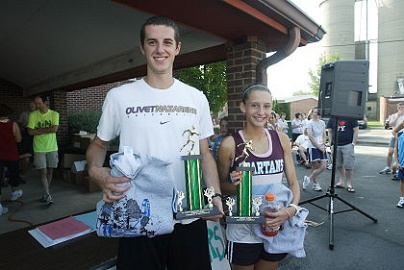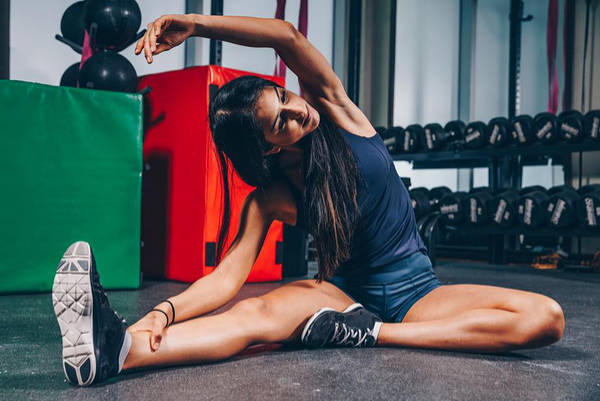
How to choose the best summer camp for your kids

Sudden cardiac arrest and women, it can happen to women in their 30s
 by Paul Arco
by Paul ArcoOSF Healthcare

OSF Cardiovascular Institute
- Fainting
- Dizziness
- Racing or irregular heartbeat
- Chest pain
- Shortness of breath
- Nausea
Myth busting hygene, common health misconceptions you should ignore

 by Tim Ditman
by Tim DitmanOSF Healthcare

Exercising in your golden years, the right way to go about it

 by Tim Ditman
by Tim DitmanOSF Healthcare
24 area runners compete at Siberian Express

Summer camp for young burn survivors in Illinois June 18-24

In this judgment-free environment, survivors can feel more open to sharing their challenges with others who have had similar experiences. Campers enjoy activities such as wall climbing, horseback riding, fishing, a high ropes course, a talent show, crafts and more – that bring them together to be supportive of one another. "Due to a generous network of sponsors, donors and volunteers, we are able to offer this unique and empowering experience free of charge to survivors of burn injuries due to fire, electricity, chemicals and even scalding water," said Jim Kreher, the Camp I Am Me President and Fire Chief of the Barrington Countryside Fire Protection District. "We invite anyone who wants to support our mission to get involved with this special journey of healing." An overarching goal of Summer Camp, as well as other Camp I Am Me programs, is to help burn survivors build back their self-esteem and confidence. Over the last three+ decades, Summer Camp has positively impacted hundreds of lives, evidenced by campers coming back year after year, and the fact that more than a fourth of its volunteers are survivors who previously attended camp as a young person. "It’s truly heartwarming to see how camp can positively impact these young people. It provides them with a strong support system filled with people who understand their experiences, which can change their lives for the better – both emotionally and psychologically," said Philip Zaleski, Camp I Am Me Executive Director. Members of Illinois’ fire service and medical community, along with educators and individuals from the private sector, volunteer at the Summer Camp, where there is always a goal to have a one-to-one, volunteer to camper ratio. While Camp I Am Me has met its volunteer needs for this year’s Summer Camp, there are other ways to get involved with the organization’s mission, which can be found at campiamme.org/get-involved. For more information about Summer Camp and other burn injury survivor support programs, as well as fire safety and burn prevention resources provided by Camp I Am Me, please visit campiamme.org.
Get off to a healthy start and keep your golf season injury-free

OSF Healthcare
Before tossing the clubs in the trunk, however, the first priority is getting your body ready for the long season. Hopefully, you’ve maintained some level of fitness during the winter. But if you spent the past few months watching Netflix from the couch, experts have some important advice in order to keep your body injury free, especially to start the season.
“I would just start a stretching routine," says Matthew Davidson, a physical therapist with OSF HealthCare. "Start there, work on flexibility a little bit, range of motion, try and do what you can to counteract that stiffness that you seem to get over the winter months. Cardiovascular exercises are really good because they can not only build up that system, but improve blood flow and help with weight loss for those who might have gained a few pounds over the winter."
For the most part, golf is a relatively safe sport, but injuries can happen, especially as a result of not using proper form or technique. Most golf-related injuries involve the lower back, shoulders, wrists, and elbows. Walking nine or 18 holes can be challenging, especially if you’ve been mostly sedentary for the past several months. Even carrying a golf bag can cause back and shoulder pain. That’s why it’s important to start making changes immediately. Flexibility is the key. It will promote mobility, which helps joints throughout the entire body.
"First of all, depending on your fitness level you might want to start with nine holes before 18," says Davidson. "You might want to go to the range and walk between the range and the putting green. As far as a walking routine, start with five or 10 minutes. Walk your dog around the block and increase the distance and ramp it up from there."
Before starting any round, give yourself at least 10-15 minutes to properly stretch your back, hamstrings, abdominals, arms and shoulders to stay flexible. And make sure to get plenty of practice swings in before you head over to the first tee.

"One of the main things we do is sit," says Davidson. "We sit at our desk, we sit and watch TV, and we sit to relax. Golf is all about maintaining really good posture. Get to the golf course early, try a few swings, and go to the putting green. If you have time, go to the driving range and start with the smaller irons and work your way up to the driver and not just on the first hole with the first swing."
And remember to swing properly. The keys of a good swing include good posture, a stable lower back, and a slow relaxed swing. Most injuries that happen on the course are a result of poor form and an incorrect swing. An early-season injury, especially during cooler temperatures, can really set back a golfer for a period of time.
"Muscle strains, if they’re simple, can take anywhere from a few days or if they’re severe a month or longer, it just depends on the person," says Davidson. "My advice is to use pain as your guide. If you’re feeling something isn’t right don’t try and go out there and be a hero. Rest up, ice, use heat, whatever you need to do to manage it. And if it doesn’t improve, certainly go see your physician."
For more information on preparing for the golf season, click here.

Good sleep habits help weight loss and cardiovascular health
Smart devices are triggering a real pain in the neck for some people

OSF Healthcare
But with all this screen time comes potential health problems. A condition known as “tech neck” is the stressing of the muscles while looking down at items such as phones or computers for long periods of time.
“Technology which is affecting your neck is the best way I can put it," says Dr. Nandini Chattopadhyay, a family practice physician with OSF HealthCare. "Technology can mean phones, iPhones, tablets, computers and their overall effect on the neck, shoulders, upper back, which has been a problem in the recent years and that’s what tech neck is all about.”
Some are calling this problem the new carpal tunnel syndrome.
“In tech neck, we see the neck being affected because of the technology," says Dr. Chattopadhyay. "More often than not, it's the nerves which are running from the back of the head to your neck and shoulders, which becomes weak because of the way that people do these activities and looking at technology devices. The relationship between nerve and pain in terms of neck is now called the new carpal tunnel of this era.”
Tech neck affects both adults and children, but symptoms vary and can be different for each person, says Dr. Chattopadhyay, who has treated patients as young as five. The repetitive strain on the bones, nerves, and muscles caused by looking down at a phone or laptop, for example, can cause joint inflammation, pinched nerves, arthritis, and even herniated discs.
So if I started at the head, then it can be headaches, changes in vision and needing glasses at a much younger age than what you would usually need," says Dr. Chattopadhyay. "Then it’s a lot of neck stiffness, then weakness of your upper back. A lot of tension of the muscles on the upper back. Gradually the pain goes all the way down to the lower back and then you feel numbness and tingling in your arms. These are some of the common symptoms that I see.”

There are ways to prevent tech neck, such as maintaining good posture, using a smartphone holder, investing in a monitor stand and asking your doctor about physical therapy. The good news is there are treatments that can be effective for tech neck. There’s no need to live with pain if it can be treated, says Dr. Chattopadhyay.
“The management of this comes with the awareness," she adds. "So daily exercises, making sure you're moving around, and have the ability to take breaks from technology devices. That's very important if you're working on the computer every day, then take one or two hours just to yourself to do regular exercises where you're not looking at the computer screen.”
Our phones and other devices are important tools and there’s no reason to give them up, Dr. Chattopadhyay adds. But she does recommends holding the phone at eye level to help reduce the strain. But if you continue to experience any pain, it might be time to visit your doctor.
Concussion symptoms can show up later than you expected

OSF Healthcare
Health tip: Exercise boosts immunity during winter months


"Strenuous activities such as walking through heavy snow or snow shoveling can add stressors to the heart that people aren’t normally used to," said Osborne "Our hearts also have to work extra hard in cold weather to keep a healthy body temperature." Here are some tips to keep your heart in check during coat season:
Reach your 2022 goals with an ‘anti’ resolution list

As we continue to weather the COVID-19 pandemic, improving overall health is front and center, more so than usual. However, according to the U.S. New Year’s Resolutions 2020 study conducted by YouGov, over half of those who set New Year’s resolutions can’t follow through.
Luckily, exercise physiologist and Bowflex fitness advisor Tom Holland has a new approach to setting and reaching your health and fitness goals this year.
Focus on Anti-Resolutions
Holland recommends turning the typical New Year’s resolutions list on its head by creating “anti-resolutions” to focus on what you’re not going to do. For example, instead of saying “I’m going to work out every day” or “eat only healthy foods,” resolve to not make excuses. This can take the focus off the broader goal and onto in-the-moment actions. The next time you plan to go the gym or cook a healthy meal, and you start to come up with reasons today’s not the day, you can remember your resolution to not make excuses. If you set unrealistic resolutions to transform your entire lifestyle all at once, it’s more difficult to take the necessary steps to get there.
Most people have made excuses for not making a workout or sticking to a routine. This anti-resolution approach changes the focus from overly ambitious goals to a more subtle mindset shift.
To help you continue or take those first steps on your fitness journey, Holland also recommends connected fitness services and apps, such as the JRNY digital fitness platform. With the JRNY app, you can easily fit exercise into your schedule with a wide range of personalized, trainer-led workouts. JRNY is integrated with Bowflex cardio equipment, including stationary bikes and treadmills, and features off-product workouts such as HIIT, strength, yoga, stretch and Pilates, which can be accessed from a mobile device or tablet via the JRNY app. So many options means no more excuses. No matter your fitness level, goals or lifestyle, JRNY has exercise programs to help you stay motivated and active so you can make exercise a habit in your life.
Determine What Works Best for You
Often people struggle to get started working out because they think they need to go to the gym all the time or sacrifice privacy, comfort and entertainment to see results. Holland notes that it’s important to not let trends, other people’s opinions or even your own preconceived notions get in the way.
It’s easier than ever before to find a workout routine that aligns with your lifestyle. If going to the gym isn’t your speed, you could pick up a versatile fitness product such as a set of Bowflex SelectTech 552 dumbbells or download the JRNY mobile app for access to hundreds of video workouts that can be done from the comfort of your own home—no expensive gym membership or commute required.
If you find your motivation is dwindling, the Bowflex Max Total 16 is a great option that lets you do high-intensity, interval workouts at home while streaming your entertainment subscriptions including Netflix, Hulu, Amazon Prime Video, HBO Max, and Disney+.
This new year, try a different approach to health and fitness resolutions by kicking the overly ambitious goals of the past to the side in favor of setting anti-resolutions instead. At the same time, take advantage of what today’s fitness technology has to offer to improve your odds of success and make this your year.
Tips for a healthy heart during the holidays
The American Heart Association, the world’s leading nonprofit organization focused on heart and brain health for all, has tips and resources to help you and yours have a happy, healthy holiday season.
"The holidays are a busy, often stressful, time for most of us. Routines are disrupted; we may tend to eat and drink more and exercise and relax less. We also may not be listening to our bodies or paying attention to warning signs, thinking it can wait until after the new year. All of these can be contributors to increasing the risk for heart attack at this time of the year," said Donald Lloyd-Jones, M.D., Sc.M., FAHA, volunteer president of the American Heart Association and Eileen M. Foell Professor of Heart Research, professor of preventive medicine, medicine and pediatrics, and chair of the department of preventive medicine at Northwestern University’s Feinberg School of Medicine in Chicago. "This may be even more likely for many people who didn't get to be with family and friends last year due to COVID1-19 restrictions. It's incredibly important to be aware of these risks. Take a few simple steps that can help keep you heart healthy with much to celebrate in the new year."
Here are some things to be mindful of (a list we recommend checking twice):
- Know the symptoms and take action: Heart attack signs may vary in men and women and it’s important to catch them early and call 9-1-1 for help. The sooner medical treatment begins, the better the chances of survival and preventing heart damage.
- Celebrate in moderation ‘Tis the season for unhealthy changes in diet and higher alcohol consumption. Eating healthfully during the holidays doesn’t have to mean depriving yourself, there are still ways to eat smart. Look for small, healthy changes and swaps you can make so you continue to feel your best while eating and drinking in moderation, and don’t forget to watch the sodium.
- Plan for peace on earth and goodwill toward yourself: Make time to take care of yourself during the busy holiday. Reduce stress from family interactions, strained finances, hectic schedules and other stressors that tack on this time of year, including traveling.
- Keep moving: The American Heart Association recommends at least 150 minutes of physical activity per week and this number usually drops during the holiday buzz. Get creative with ways to stay active, even if it’s going for a family walk or another fun activity you can do with your loved ones.
- Stick to your meds: Busy holidays can make way for skipping medications, forgetting them when away from home, or not getting refills in a timely manner. Here is a medication chart to help stay on top of it, and be sure to keep tabs on your blood pressure numbers.
2022 fitness trends continue to evolve into new norms

Exercising at home has become a norm for many. Everything from resistance training and free weights to yoga and pilates have been molded into quick, no-fuss training self-directed routines between Zoom sessions for those wanting to maintain a healthy lifestyle. In addition to solo workouts, sweat sessions with quarantine partners and bubble mates for those who need motivational pushes, are still going strong.
“We’ve learned that wellness is not one-size fits all, and that it’s achieved by small habits like regular hydration that can really impact how you feel throughout the day,” said celebrity fitness trainer Harley Pasternak, MsC. “Collectively, nourishing both body and mind together as one makes holistic health a sustainable lifestyle.”
Pasternak and the experts at Propel Fitness Water are forecasting five fitness and wellness trends to watch for in 2022:
Accountability Buddies
When gym closures ran rampant, folks leaned on others for inspiration to get moving, so it’s no surprise working out in pairs (or more) is a continued way to focus on fitness. Feelings of burnout may be common heading into 2022, so having a partner who gives you a healthy sense of camaraderie and competition can help push you to show up on days when you’d rather rest and stay committed to your goals. It also provides a sounding board when you need suggestions for nutritious recipes or fresh at-home cardio ideas.
Versatility in Gym Spaces and Schedules
When a large segment of the workforce started working from home, the rituals of before- and after-work gym visits fell by the wayside. People grew more accustomed to improvising where they work out, whether it was their neighbor’s garage, their living room or a running path in the city. As exercisers are less beholden to studio or gym schedules, the “gym anywhere” mentality is a level of flexibility many are holding on to, even as they ease back into more normal work routines.
Health in Small, Achievable Doses
This trend is all about recognizing health transformations don’t happen overnight, and even modest steps can make a big difference in how you feel throughout the day. One example is paying more attention to your hydration. If you aren’t properly hydrated, few other things tend to go right either. Small habits like throwing Propel Powder Packs into your gym, work or school bag can make a difference. Filled with enough electrolytes to replace what is lost in sweat, they are handy for on-the-go hydration and are easy to add to a water bottle.
Wellness Goals vs. Fitness
Committing to overall wellness is more about lifestyle changes than numbers like weight loss or muscle mass. People embracing this trend are forgoing numeric goals based on performance in the gym or on the scale and instead emphasizing outcomes that affect life, nourishing both body and mind together as one. Fitness goals are an essential component, but so is supporting your mental health as well as being cognizant of what you’re putting into your body. When each piece is well taken care of, your body is better able to work like a well-oiled machine.
Low-Impact Workouts
This year, walking treadmill challenges gained virality on social media, marking the increasing popularity of workouts that are low impact yet effective. Getting moving is the key, even if it means taking your tempo down. You don’t need to do hours of HIIT every day to see results. In fact, less time- and energy-intensive workouts are easier to sustain and can often yield the same, or better, results.
Find more hydration options and wellness tips at propelwater.com.
Gentle on the joints and fun, rebounding is a great way to get fit

What is Rebounding?
Rebounding is a low-impact, high-intensity exercise on a fitness trampoline with elastic cords. It’s intuitive, gentle on the joints and, users say, a whole lot of fun. From different ways to jump, to strength and balance work, to flexibility moves, exercisers enjoy the ease, rhythm and freedom of rebounding, along with energizing music that drives workouts and helps endorphins flow. “We perform workouts to the beat of the music, which allows people to get out of their minds and focus on their bodies and movement,” explains Jacey Lambros, co-owner of Jane DO, a fitness brand with four studios in the greater New York City region. “Our trampoline class is a total-body workout designed to lift both the body and the spirit.”Benefits of Rebounding
Here are some more reasons to consider rebounding: 1. Accommodates all fitness levels. Beginners can go at their own pace and use a handlebar attached to the trampoline, while advanced exercisers can accelerate their pace and intensity for greater challenge. Both benefit from this low-impact modality, which minimizes joint stress. 2. Burns calories. Studies have shown that rebounding for 20 minutes is comparable to running for 30 minutes—without all the jarring on the body. Another study indicates that rebounding is 50 percent more efficient at burning fat than running. Plus, because workouts are low-impact, they don’t feel as taxing, so you can exercise longer for even better results. 3. Develops balance. The unstable surface of trampolines means your body has to work harder and constantly engage the core to remain balanced and in control. 4. Improves the lymphatic system. Rebounding stimulates the lymphatic system, which functions to help the body get rid of toxins and is essential for immunity and overall health. 5. Builds bone mass. Jumping on a trampoline strengthens the skeletal system to enhance bone density and help stave off osteoporosis. 6. Is compact and cost-effective. Mini-trampolines are compact and can fit anywhere (some even fold), are reasonably priced, facilitate a variety of workouts and deliver long-lasting performance over years.How to Jump In
Get a quality trampoline from an expert such as JumpSport at www.JumpSportFitness.com. You can choose among different models for various preferences and budgets. Then take advantage of on-demand and live streamed workouts, or hit a rebounding boutique. There are more than 20 fitness studios in the Tri-state area keeping exercisers bouncing with in-person and virtual rebounding sessions. In the greater NYC area, Jane DO offers its trampoline workouts, along with weekly live streamed classes, at www.janedo.com/livestream and on-demand workouts, via its custom app in the Apple Store or Google Play. "Rebounding gives you a full-body workout on a singular apparatus, in a small space, and in a way that won’t bother your neighbors," says Dani DeAngelo, co-owner of Jane DO. PERSPIROLOGY, a boutique fitness center in Sea Bright, New Jersey, also offers a wide variety of Bounce classes in studio and online that motivate and challenge exercisers. "We have hundreds of workouts on our site that allow exercisers to get familiar with rebounding and work hard in the comfort of their own home," says Katy Fraggos, owner/creator of PERSPIROLOGY. You can check out a free seven-day trial of the Workout At Home library at www.perspirology.com. Rebounding can be a great way to put more of a spring in your step all year round.1st annual Santa HO HO HO 5k Fun Run/Walk a success
During the discussion fellow runner Brenda Hixon suggested the possibility of taking another road trip. Maybe to Chicago or running in Indy again at either city's Santa Hustle. The group of avid runner decided they would indeed run one more race before the end of the year.
However, the next morning Painter, a veteran who started running while serving in the Army, woke up with a better idea.
"Why don't we just do that here?"
Painter presented the idea to the group and it was a hit.
Combining efforts Hixon and Painter created the 1st Annual St. Joe Santa HO HO HO 5k Fun Run.

As they planned the event, they expected, at best, a modest turn out of maybe 50 to 100 Santa-ly cladded runners making their way through the streets of St. Joseph. To their surprise and delight, registrations started rolling in and the field of runners and walkers quickly rose over 200.
"It exploded into this," Painter said while scanning the finish line as runners and walkers crossed the finish line to receive their medals from Mayor Tami Fruhling-Voges and other finish line volunteers. "We love it."
And by this, Painter meant the 325 participants and nearly that number of spectators, family members and well-wishers along the 5k course on Saturday.

The near freezing temperatures did not keep runners away.
"It wasn't too cold out there once you got running," said Dwayne Schlabach, who started running to stay in shape.
For Peyton Wendell the race one more opportunity to put on his holiday best, a royal blue two-pieces Christmas suit.
"My aunt bought it for me last year. I wore to school a few times and I thought this would a great time to wear it one last time," he said. "It (the run) was really fun. There were a whole bunch of people out there cheering for you."
Rhonda Littlefield, who crossed the finish line capturing her finish with her smartphone, enjoyed the race.
"I wanted to support the community and do something fun," she said echoing the sentiments of other runners as the sun peeked from behind the clouds through the crisp December air. "I didn't fall down and hurt an ankle so it's a great day. It was a lot of fun!"
Coming off a recent injury that limited his running, Gregory Poe was happy to be able to run and spend quality time with his two sons, Nick and Eric.
"I haven't been able to run for a while," he said. "I really enjoyed it and had a great time."
Hidden behind sunglasses and her Santa beard, Sara Meyer said she also enjoyed the atmosphere and holiday cheer along the course.

"I'm use to competing in more competitive races," she said before heading over to have her picture taken with someone dressed in Grinch costume. "It was something fun to do today and a great day for it."
Former St. Joseph-Ogden high school running star Chelsea Blaase was the first competitor and female runner to cross the finish line. Brandon Mattsey was the first male runner in and Kendrick Johnson was the first runner in the youth division to finish the inaugural race.
More Sentinel Stories



Photo Galleries







